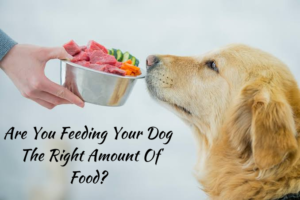
 Whether your dog’s motto is “eat to live” or “live to eat,” one of the most essential things you can do for her long-term health is to help her maintain a healthy weight, which begins with a combination of feeding the proper amount of food and providing the right amount of activity.
Whether your dog’s motto is “eat to live” or “live to eat,” one of the most essential things you can do for her long-term health is to help her maintain a healthy weight, which begins with a combination of feeding the proper amount of food and providing the right amount of activity.
But how much is the “correct” amount? How do we account for a dog’s changing nutritional requirements as they mature?
The amount of food your dog requires is determined by a number of factors. Consider her age, breed, degree of exercise, and amount of time she spends outside. Larger breeds and more active dogs, as well as dogs who spend a lot of time outside, especially in colder weather, will require more calories per day, according to the American Kennel Club (AKC).
How much to feed puppies?
Puppies’ nutritional requirements differ from those of an adult or even teenage dog. To begin with, they eat more frequently than adult dogs. Your puppy may eat up to four meals a day, or two to three times the amount of an adult dog, depending on her breed and age.
The American Kennel Club advocates using the “watch the dog, not the dish” technique. Giving puppies a meal schedule and then removing any remaining food 10-20 minutes after a meal is provided aids in the development of excellent eating habits.
This method will assist you in determining how much your puppy need and will assist your puppy in developing positive habits, such as eating when hungry.
If a puppy misses out on a meal because they don’t eat enough, their hunger will motivate them to finish it at the next feeding and learn to eat when food is available. They won’t go hungry for long because they eat frequently.
How much to feed adult dogs
Most adult dog breeds eat twice a day. If you’re adopting an adult dog and aren’t sure what she eats, two cups of age-appropriate food each day—one in the morning and one in the evening, and always with fresh water available—is a smart place to start. (Because dog food makers frequently sell foods for different phases of life, it’s simple to select a food that’s appropriate for your dog at her age.) Some dog food companies have guidelines printed on the package, which can be a good place to start and then adjust based on your dog’s current size and goal weight.
As long as the dog receives enough activity, owners of these “eat to live” canines usually have little issue keeping their dogs at a healthy weight. Some dogs thrive on this “grazing” pattern, while others can’t seem to keep themselves in check.
Those of us who have dogs who “live to eat” must assist them with portion control. If you’re having difficulties keeping your dog at a healthy weight, your veterinarian can offer advice on portion control and weight management. They may suggest a specific diet that incorporates high-end foods.
- Toy Breeds (3-6 pounds): 1/3 cup to 1/2 cup per day
- Small Breeds (10-20 pounds): 3/4 cup to 1 1/2 cups per day
- Medium Breeds (30-50 pounds) 1 3/4 to 2 2/3 cups per day
- Large Breeds: (60-100 pounds) 3 to 4 1/2 cups per day, plus 1/3 cup for every 10 pounds over 100 pounds
Non-commercial Dog Food
Several dog owners prefer to make their own dog food, which has some advantages over store-bought kibble. For starters, according to the AKC, homemade food is easier for dogs to digest, and owners who take this path can offer these meals to their dogs at any age without having to move from puppy to adult to advanced-age dog food.
If your dog has very specific nutritional needs or other health concerns, you may want to investigate this sort of diet. If you want to make your own dog food or treats, the AKC gives some recipe options.
How about some treats?
Dog treats should make up no more than 10% of your dog’s daily caloric intake as a general guideline. If you’re in a training programme, make sure you plan treats correctly so they don’t get too many.
If you have an overweight dog, think of inventive reward options that don’t add a lot of calories. We used to have a dog who enjoyed green beans, which were a great low-calorie “reward.”
Dogs’ health and obesity
Obesity in dogs is a common condition caused by a combination of too much food and insufficient exercise.
Obesity can contribute to a variety of health issues, including musculoskeletal problems, congestive heart failure, Cushings disease, skin disorders, and some types of cancer, so it’s crucial to assist your dog lose weight if she’s obese.
If your dog is overweight or obese, seek advice from your veterinarian on how to help her maintain a healthy weight.


hi